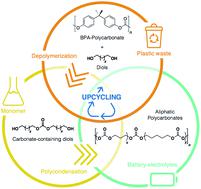当前位置:
X-MOL 学术
›
J. Mater. Chem. A
›
论文详情
Our official English website, www.x-mol.net, welcomes your
feedback! (Note: you will need to create a separate account there.)
From plastic waste to polymer electrolytes for batteries through chemical upcycling of polycarbonate
Journal of Materials Chemistry A ( IF 10.7 ) Pub Date : 2020-06-26 , DOI: 10.1039/d0ta03374j Keita Saito 1, 2, 3, 4 , Coralie Jehanno 5, 6, 7, 8 , Leire Meabe 5, 6, 7, 8, 9 , Jorge L. Olmedo-Martínez 5, 6, 7, 8 , David Mecerreyes 5, 6, 7, 8, 10 , Kazuki Fukushima 4, 11, 12, 13, 14 , Haritz Sardon 5, 6, 7, 8
Journal of Materials Chemistry A ( IF 10.7 ) Pub Date : 2020-06-26 , DOI: 10.1039/d0ta03374j Keita Saito 1, 2, 3, 4 , Coralie Jehanno 5, 6, 7, 8 , Leire Meabe 5, 6, 7, 8, 9 , Jorge L. Olmedo-Martínez 5, 6, 7, 8 , David Mecerreyes 5, 6, 7, 8, 10 , Kazuki Fukushima 4, 11, 12, 13, 14 , Haritz Sardon 5, 6, 7, 8
Affiliation

|
The constant increase of plastic waste released into the environment is a global problem which is raising concern to the general population. Although there are many different approaches for recycling plastics, chemical recycling is currently seen as one of the most promising technologies in that it allows plastic waste to fit into a sustainable, circular economy. Herein we investigate the chemical recycling of bisphenol A polycarbonate (BPA-PC) using diols of different chain lengths to yield bisphenol A and innovative carbonate-containing diols. Subsequently, the latter are polymerised into a series of unique value-added aliphatic polycarbonates (APC). The new polymers obtained by this method have shown promising values of ionic conductivity that make them attractive candidates to be implemented as sustainable polymer electrolytes for solid-state batteries. This procedure opens the way for recycling methods to produce unique, innovative materials using plastic waste as an alternative sustainable feedstock.
中文翻译:

从塑料废料到电池的聚合物电解质,通过聚碳酸酯的化学循环再生
不断释放到环境中的塑料废料是一个全球性问题,引起了普通民众的关注。尽管有许多不同的方法来回收塑料,但化学回收目前被认为是最有前途的技术之一,因为它可以使塑料废料适应可持续的循环经济。在这里,我们研究了使用不同链长的二醇对双酚A聚碳酸酯(BPA-PC)进行化学回收,以生产双酚A和创新的含碳酸酯的二醇。随后,后者被聚合成一系列独特的增值脂肪族聚碳酸酯(APC)。通过这种方法获得的新聚合物已经显示出令人信服的离子电导率值,这使其成为有吸引力的候选材料,可以用作固态电池的可持续聚合物电解质。该程序为利用塑料废料作为替代可持续原料生产独特创新材料的回收方法开辟了道路。
更新日期:2020-07-21
中文翻译:

从塑料废料到电池的聚合物电解质,通过聚碳酸酯的化学循环再生
不断释放到环境中的塑料废料是一个全球性问题,引起了普通民众的关注。尽管有许多不同的方法来回收塑料,但化学回收目前被认为是最有前途的技术之一,因为它可以使塑料废料适应可持续的循环经济。在这里,我们研究了使用不同链长的二醇对双酚A聚碳酸酯(BPA-PC)进行化学回收,以生产双酚A和创新的含碳酸酯的二醇。随后,后者被聚合成一系列独特的增值脂肪族聚碳酸酯(APC)。通过这种方法获得的新聚合物已经显示出令人信服的离子电导率值,这使其成为有吸引力的候选材料,可以用作固态电池的可持续聚合物电解质。该程序为利用塑料废料作为替代可持续原料生产独特创新材料的回收方法开辟了道路。










































 京公网安备 11010802027423号
京公网安备 11010802027423号